These are surely the best-known Japanese tunnels in Hong kong. The "Outlying Islands" sheet of the Countryside map series shows the location of one of them, titled 'Cave Kamikaze". That trips off the tongue, but of course it is really a man-made tunnel, not a natural cave.
Then the 'kamikaze' label is widely used, but I'm not sure what the original evidence is [UPDATE: We've since found lots of evidence, see the comments below]. The government's website gives the description: Situated in between Lo So Shing and So Kwu Wan is Kamikaze Cave which is constructed by the Japanese to house a flotilla of suicide motorboats.
The only references I can find that come from near the time they were built are these two:
- H.M.S. VENERABLE (COLOSSUS Class Light Fleet aircraft carrier), 30th Aug 1945: 'Launched air attacks on Japanese craft in Lammas Bay.'
- H.M.S. INDOMITABLE (Modified ILLUSTRIOUS-Class Fleet Aircraft Carrier), 30th Aug 1945: 'Carried out air attacks with HMS VENERABLE on Japanese explosive boats in Lamma Bay'.
These two aircraft carriers were part of the fleet that sailed to Hong Kong to accept the Japanese surrender, and re-establish British control. It's not clear how they knew of the Japanese explosive boats, and whether those boats were stored in these tunnels or not. Does anyone have any more information about these?
Back to the tunnels today. If you're walking from Sok Kwu Wan, here's the first one you'll see:
I think there used to be a village-style rubbish incinerator here, and elsewhere I've read that the tunnel was used by the villagers as a rubbish dump. It's sealed up now.
Here's #2, which is open and accessible. There's water in the tunnels for much of the year, but at the end of the dry season it's just a bit damp.
On to #3. This has a couple of noticeboards. One describes how Romer's tree frog has been found in the caves, and the other repeats the Kamikaze story. It calls them the "kamikaze grottoes", an odd choice of words, conjuring images of grim-faced soldiers surrounded by fairy lights.
You can see the tunnels are roughly finished, quite different from the smoothly arched tunnels that were dug up in the hills. Here's a photo of the back wall:
At about 7 o' clock on the photo you can see a round dark circle. There are these drill holes in the back wall of each of the tunnels. Likely the tunnels were formed by boring holes, inserting explosives, then blowing away the rock.
Tunnel #4 is quite overgrown with a prickly vine. Later in the year when it's all growing, the tunnel is hidden.
Here's the view looking out from the back, to give a sense of scale.
And here's the view looking up. This was the only one of the tunnels that we saw bats in.

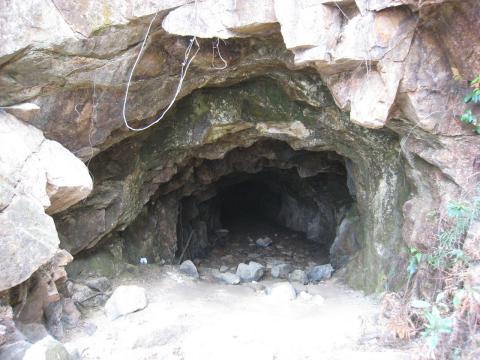
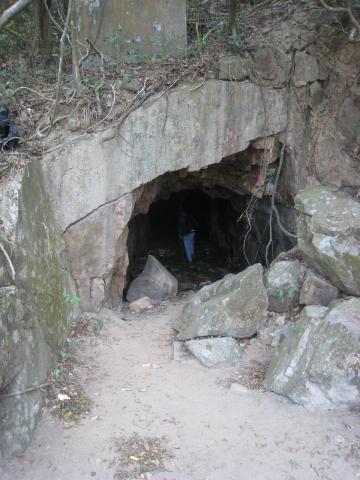
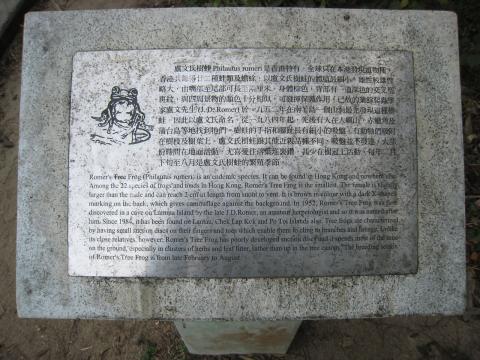
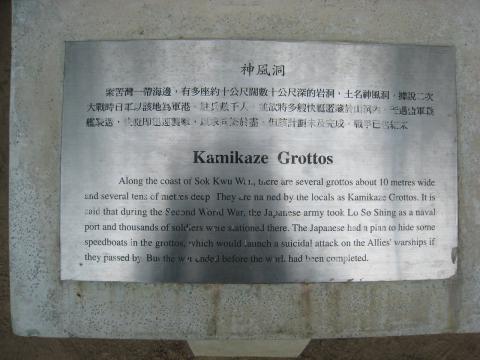
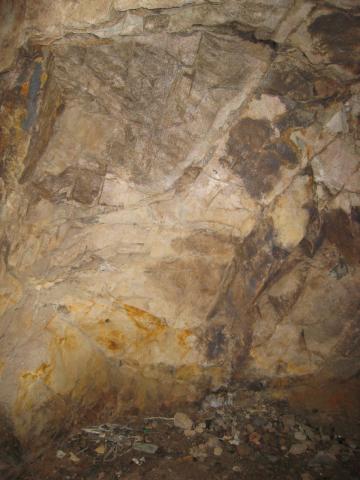

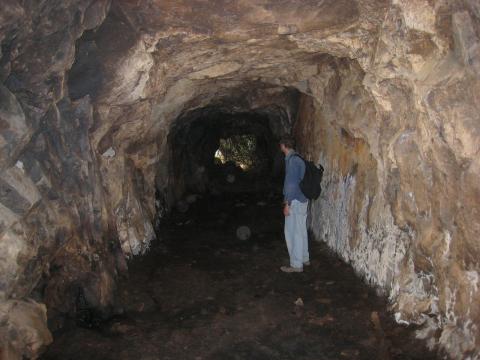
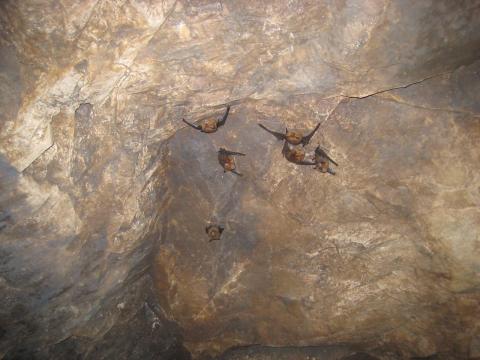

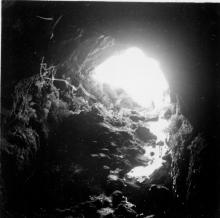
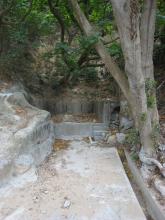
Comments
Kamikaze Boats
This photo shows the kamikaze boats on Lamma Island that were destroyed and captured by the British naval forces soon after the re-occupation of Hong Kong in AUG 1945:
http://london.iwm.org.uk/server/show/conMediaFile.47362
Further photo. Look under KT102:
http://www.royalnavyresearcharchive.org.uk/MONABS/KT_Album.htm
re: kamikaze boats
Good find - the IWM photo especially, as it shows the boats right in front of a tunnel.
I wonder where how it was decided they were kamikaze boats though? I guess if they were found packed with explosives, that would be pretty conclusive.
Re: Kamikaze Boats
The China Mail on 11 September 1945 reported the existence of a potential Kamikaze Corps during the rounding-up of Japanese military forces. The men found on Stonecutters Island were organised into a suicide squad operating miniature torpedo boats. A considerable number of craft were found at Stonecutters.
Not sure if there were other locations for the concealment of these suiciide boats or that the correspondent may have incorrectly stated the location as Stonecutters and not Lamma.
Kamikaze Boats
The first photo that Moddsey linked, showing the Kamikaze boats on Lamma appears to be the first cave in the photos above which is fully blocked off with a tree on the right.
I had a quick look about on the inter-web and found a little more information on the boats;
In 1937, Japanese hull designers began a
study of existing British, Italian and American motor and torpedo boats. Many
models were made. By 1941, they completed their own design of six 18-meter
motor torpedo boats. At the beginning of the war, these models were put into
production.
In March 1944, the Shinyo ("Sea Quake") manned
explosive motorboat (EMB) program was begun. The first models were copied from
the 18-meter motor torpedo boats. Six steel hulled boats were constructed at
Yokosuka Naval Base and two wooden hulled EMBs were built at Tsurumi, Yokohama.
On 27 May 1944, the first Shinyo EMBs
were tested. Difficulties were encountered with the design and it was
determined to abandon steel hulls in favor of wooden hulls because of the
availability of materials.
On 1 August 1944, over 400 new students
arrived at the Naval Torpedo School
facility at Kawatana on Omura Bay, near Yokosuka.
Captain Hara Tameichi (former CO of DesRon 27) was Senior Instructor. The
students, all would-be aircraft pilots, had been transferred from aviation
schools because of the lack of aircraft production. Their average age was 17
years. The students were given the choice of training for duty with
conventional torpedo boats, Special Attack (suicide) boats or as suicide
frogmen. About 150 of the first students chose the Special Attack EMBs.
A three-month training period in
small-boat handling, mechanics and attack techniques was prescribed for EMB
units, but the early squadrons were soon deployed in the defense of the
Philippines, Okinawa, Formosa and Hainan Island. In September 1944, the 1st,
2nd and 5th Shinyo Squadrons were sent to Chichijima in the Bonin Islands, the
3rd and 4th Shinyo Squadrons to Hahajima, Bonins, while the 6th Shinyo Squadron
went to the Philippines.
In October-November 1944, EMB training "officially" commenced.
Type 1 one-man Shinyo EMBs were
relatively slow and only capable of speeds up to about 23 knots. When carrying
a warhead, their top speed dropped off to a dismal 18 knots. Typically, Navy
EMBs were equipped with a bow-mounted explosive charge. Army EMBs carried two
depth charges and were not considered suicide boats, as the pilot was supposed
to drop the depth charges and U-turn around in the 6-seconds before they
exploded. In reality, there was no way to get away safely from the explosion.
The slightly larger and faster two-man
Type 5 Shinyo EMBs were powered by two automobile engines. Armed with a 13.2mm
heavy machine gun, they were designed to serve as command boats. Both Type 1
and Type 5 Shinyo were equipped with two 120-mm RO-SA rockets (same type used
on ISE and HYUGA, not rocket guns) to increase speed during the final run-in
and as makeshift propulsion in case of engine failure. The engine(s) for both
versions was designated as Toyota KC Special Type. Some Type 5 Shinyo were
equipped with radio telephones.
A total of 6,197 Shinyo EMBs were
manufactured for the Imperial Japanese Navy and 3,000 somewhat similar
"Maru-ni" EMBs for the Imperial Japanese Army. Around 1,100 boats
were transported to the Philippines,
400 to Okinawa and Formosa,
and smaller numbers to Korea,
Shanghai, Hong Kong, Hainan and Singapore. The
vast majority of EMBs were stored along he shores of coastal Japan for defense against the expected invasion
of the Home Islands. The Naval General Staff
expected a 10 percent hit rate for Shinyo EMBs.
EMBs scored some limited successes in
the Philippines and Okinawa, but heavy gunfire from Allied ships and PT-boats
("fly-catchers") stopped most of them. Others were lost in transit,
met with accidents, or were strafed and sunk by American aircraft.
No detailed production records of EMBs
have been located by the authors; however, Japanese and Allied records do
contain some information concerning EMB operations. As a result, although we
cannot present EMB data in our usual Tabular Record of Movement (TROM) format,
we have chosen to present the information by geographical areas of operation
and time periods as listed below.
Shinyo
and Maru-ni -- Motorboat with explosives
in the bow.
Great
numbers -- 6,200 Navy (Shinyo) and 3,000 Army (Maru-ni) -- were built and
stored in caves for the invasion. 400 were at Okinawa and Formosa ; thousands waited in the coves of Japan proper.
The speedboat had one man and, typically, two depth charges as explosives. A
slightly larger 2-man speedboat was also available.
damaged and two gunboats sunk by Japanese suicide boats in Lingayen Gulf, Luzon, Philippines. War Hawk (AP-161) 81 killed..
Philippine Islands.
Japanese suicide boat in Buckner
Bay, Okinawa,
and not repaired after the end of the war.
RE: Kamikaze Boats - Hong Kong 1945
Good work Craig and nice pictures.
From the HMS Vengeance website and memories of Charles Davidson, P.O. 812 Sqdn:
http://www.hms-vengeance.co.uk/index.htm
"I can see quite clearly in my mind an early sunny morning when I saw the coast of China. We were at Action Stations. The aircraft flew overhead us as we steamed between the rocky islands off Hong Kong slowly for fear of mines. The Bofors guns were manned and depressed and I remember they opened up when I was below decks and was told some Japanese had loaded a little boat with dynamite and darted out from the lee of an isle, then lashed the wheel and set it at full throttke to collide with the ship and jumped into the sea. They sunk the boat well away from the Vengeance. Later in the Hong Kong Dockyard several of these home made craft were found to be powered by engines taken from the old British built Leyland (?) buses that ran in the Colony before the war."
1945 Kamikaze Boats (Lamma Island)
I've set the completion date
I've set the completion date to Feb 1945 based on information at http://www.combinedfleet.com/HongKongEMB.htm:
January-February 1945:
The IJN deploys the 35th, 36th and 107th Special Attack Shinyo Squadrons to Hong Kong. The 35 SS has an authorized strength of 185 men and 52 EMBs, 35 SS has 188 men and 50 EMBs, including two Type 5 Shinyo, and 107th SS has 186 men and 25 EMBs, Lamma Island, Hong Kong. Kamikaze Cave, situated between Lo So Shing and So Kwu Wan, is constructed by the Japanese to house an unknown squadron of Shinyo Explosive Motorboats (EMB).
Regards, David
Kamikaze boat crews
four photos here of them surrendering - one is as shown above. good resolution
http://handle.slv.vic.gov.au/10381/158442
re: link
doesn't seem to work when you click on it, but does if you copy and paste into address bar
re: link
The link seems tempermental - works sometimes but not always.
Great set of photos - it's amazing how much is coming out of the woodwork over time.
Regards, David
I wonder if these 3 extracts
I wonder if these 3 extracts from the BAAG Situation Reports have a connection to the Kamakaze tunnels:
Re: Photos
Yes, the IWM photo was of the abandoned Japanese boats at Picnic Bay, Lamma Island
Here are the new links: http://www.iwm.org.uk/collections/item/object/205187664 and http://www.royalnavyresearcharchive.org.uk/MONABS/M8_Album.htm#.Vc1XGvm… (flip through for KT 102)
Best Regards
re: I wonder if these 3 extracts
Thanks Elizabeth, interesting to see mentions of Lamma as I've wondered what it was used for during the Japanese occupation. I've a vague memory of reading it was used as a Japanese Naval base, but now I wonder if that just refers to these kamikaze boats installed near the end of the war.
Regards, David
In the Ride Collection I
In the Ride Collection I found this newspaper cutting from the South China Morning Post of Sunday November 30th 1975:
"CONFRONTED BY JAPANESE SUICIDE BOATS.
1945 HMCS Prince Robert - Captured Japanese Suicide Boat
In 1945, HMCS Prince Robert had brought back to Canada a captured Japanese suicide boat from Hong Kong as noted here Would be interesting to find out whatever happened to it. The Australian War Memorial warehouse collection has a photo of a Shinyo suicide boat captured at Sandakan.
Moddsey might be interested
Moddsey might be interested in this report in KWIZ #79, dated 29.12.1944:
"Suicide Surface Craft. Various shipyards in Hongkong have received orders to build motor speed boats called "Despatch Boats" or "Surface Flying Mines". These are of all-wood construction, 15 ft in length and fitted with diesel engines, with a one-man crew and explosives loaded in the bow, they are designed for suicidal attack on enemy shipping. .."
Regards, Elizabeth.
Interesting Information
Thank you.
I remember seeing these in
I remember seeing these in 1958 from the opposite side of the bay. At that time I was told they were used for mini submarines!
Nice to see this story resurrected as it seems to have been overlooked in the passing years
Suicide boats
The Imperial War Museum in London holds many reels of film taken by a Naval war photographer during the re-occupation of Hongkong in 1945. Special Collections in the HKU Library have acquired copies of many of these films (5 discs). From the description of contents of these five disks, I quote the following sequences which show the Japanese tunnels at Picnic Bay and the subsequent activity by the planes on board the naval ship:
“Disc 4 (7-Adm 1200:
Disc 5 (2-Adm 1196:
Further sequences concerning the re-occupation of Hongkong are described in Post 1e [Hong Kong Reclaimed > “Re- Occupation films”] of my website ElizabethRideArchive.com.
A Happy New Year to all readers of Gwulo!
re: Suicide boats
Thank you Elizabeth, and best wishes to you for the new year ahead. It's great to see your website filling out.